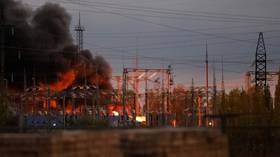China and Russia are teaming up against NASA in the race to put a base on the Moon

America may have got to the Moon first, but now, with much more than simply bragging rights at stake, Beijing and Moscow are joining forces to gain the first lunar foothold of the 21st century.
When Apollo 11 landed on the Moon in 1969, it was one of, if not the most, iconic moments in human history; and it had immense geopolitical consequences. For the previous decade and a half, the United States and the Soviet Union were locked in a high-stakes space race with each power seeking to demonstrate their technological and ideological might in opening up the ‘final frontier’, setting off a legacy that would capture the global public imagination even to this present day. Yet it was not as one-sided as America claimed, don’t forget that Moscow previously beat Washington on every step of the journey, placing the first satellite, animal, man, and woman into space, yet America ultimately stole the show with Neil Armstrong’s “giant leap for mankind.”
Now, 53 years later, history may be about to repeat itself, in some respects. The Moon is lighting itself up again in the eyes of the major powers, but for more practical and tangible reasons, as opposed to ones of sentimentality or pride, amidst what has been widely described as a “New Cold War.” This time, it’s largely between the United States and the People’s Republic of China, but also in the mix is the Russian Federation. With Moscow teaming up with Beijing, a new race to the Moon has already kicked off, not just to simply reach it, but to build on it, a competition to claim yet another historically defining moment, the first man-made structures and facilities ever built ‘off world’, a development which will have enormous military and strategic implications.
The NASA Artemis program and the militarization of space
The first space race was, so to speak, baby steps. Just as an infant learns to walk, the USSR and USA were struggling for the basics of accessing space. Sputnik was an unprecedented technology at the time, yet it only had a fraction of the processing power our smartphones do today. It stands to reason that, as our technological capabilities have advanced, the capacity of what can be done in space has grown too, which brings new implications on how it is used, not least of a military design. Things such as satellites are increasingly being given focus as active instruments of warfare, meaning the defense strategies of governments have shifted.
When Donald Trump launched “Space Force” a few years ago, the idea was widely ridiculed, not least for its seemingly Star Trek-inspired logo. It was easy to write this off as a vanity project, an example of his apparent stupidity. Except it wasn’t. The creation of a space force was not a “Trump” thing but a strategic shift by the Pentagon, which now sees space as a critical military frontier. It is seen as a necessity for the US to gain military supremacy over both Moscow and Beijing not just on air, land or sea, but in space too.
With Space Force in 2017 came the NASA Artemis program. The program’s goal is to return humans to the Moon in the short-term and, in the long run, to develop the utilization of the lunar surface into a strategic resource, eventually establishing a permanent human presence. This will include a series of run-up missions towards the setting up of a lunar satellite, a base camp, telecommunications networks, and a way paved to extract economic resources from the Moon. In every aspect, the Moon is no longer a spectacle for America to behold, but something to dominate. Artemis will be, like Apollo, a historical gamechanger.
The rise of China as a space power
That is, of course, if they get there first. America’s interstellar ambitions could well be confined by the fact that others, namely China, are also shopping for lunar real estate. Despite Washington’s attempt to contain China’s space rise by banning it from cooperation with NASA in 2011, Beijing has rocketed up to pace with Washington through a flurry of space achievements in a short space of time and similarly, has the Moon in its sights. In 2019, the Chang’e-4 probe landed on the far side of the Moon, a historic first. In 2020, Chang’e-5 returned material from the Moon and then in 2021, China launched its own Tiangong Space Station and landed on Mars.
But China does not intend to simply catch up with NASA, it intends to leapfrog it entirely. With this in mind, it is now teaming up with Moscow to propose the creation of its own Moon base, the ‘International Lunar Research Station’ by 2035, and condemning Washington’s Artemis for seeking to build a “space-based NATO.” China’s increasingly close relationship with Russia has developed amid common challenges presented by the US and has consolidated growing cooperation in the fields of science, technology, and arms.
The proposed base is the pinnacle of their complementary interests, combining Russia’s veteran space expertise and experience with China’s technological and economic might. The proposed base is described by the Global Times as having “an Earth-to-lunar flight system, an auxiliary long-term operation system on the lunar surface, a lunar surface travel and operations system, and automatic facilities with complexes of scientific instruments.” Both parties signed a memorandum of understanding on it last year and are expected to flesh out a comprehensive plan this year. After the construction of the base, China has also proposed manned missions to Mars.
The new space race is on
If it wasn’t clear already, the new space race is about not just who can reach the Moon, but who can dominate, exploit and utilize it. It is a question of who builds lunar telecommunications infrastructure, who gets its resources, who furthers their research, who makes it more accessible to humanity, who uses it first as a launchpad for missions deeper into space, and who gets the military edge from it. Only a decade or so ago this stuff might have still seemed like science fiction, but it is here, and things are only going to move faster. China and Russia are taking the fight to NASA. The coming decade will have huge implications for humanity. For those of us who weren’t around to see the first space race in the 1950s and ’60s, what a time to be alive.
The statements, views and opinions expressed in this column are solely those of the author and do not necessarily represent those of RT.


















